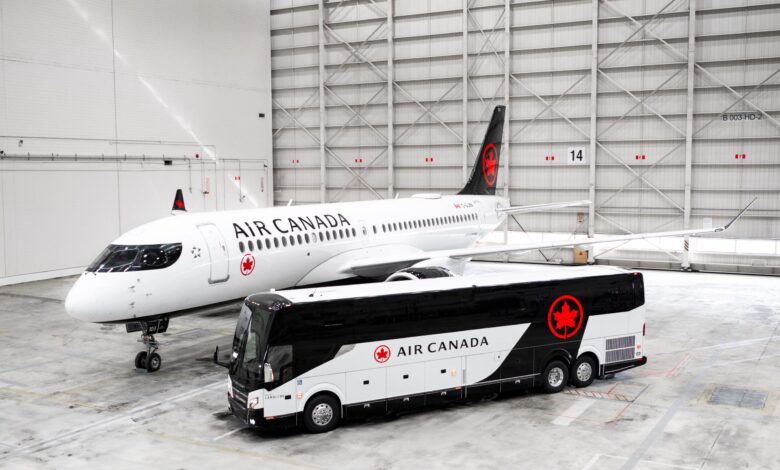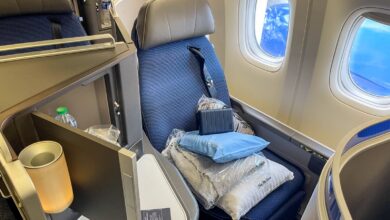Air Canada expands Toronto hub with 2 new Landline bus destinations

Air Canada flyers will have two new Toronto-area destinations to choose from come May. That’s when Landline, the flight-on-a-bus operator that partners with the likes of American Airlines and United Airlines, will launch new “flights” connecting Hamilton and Kitchener in Ontario to Air Canada’s hub at Toronto Pearson Airport (YYZ).
Landline will offer six daily round trips for Air Canada between YYZ and both John C. Munro Hamilton International Airport (YHM) and Region of Waterloo International Airport (YKF) in Kitchener from May 1. Both are new destinations for the Star Alliance carrier. The airports are currently served by other airlines, including Lynx Air and WestJet at YHM and Flair Airlines at YKF, according to Cirium Diio schedules.
Buses will operate with Air Canada flight numbers, similar to Air Canada Express flights, with seat assignments and checked bags included. One-way trips between YYZ and both YHM and YKF are estimated at one hour to one hour and 10 minutes.
Want more airline-specific news? Sign up for TPG’s free biweekly Aviation newsletter.
As an added perk, passengers can expect free “inflight” Wi-Fi.
“Air Canada is focused on improving regional services,” said Alexandre Lefèvre, vice president of network planning for North America at Air Canada. “Through this innovative partnership with The Landline Company, we are connecting communities and extending our network by offering customers a convenient, stress-free multimodal option.”
The network additions come as airlines around the world pull back on regional flying. These cuts come as airline costs have risen following the coronavirus pandemic, various staffing shortages that have hindered operations and climate considerations taking a newfound prominence. The net result is that smaller cities have less air service today than they did before the pandemic.
Air Canada has cut 10 smaller Canadian cities from its map since 2019, Cirium Diio schedules show. They include Kingston and Sarnia in Ontario, Penticton in British Columbia and Val d’Or in Quebec.
A landside bus connection at Toronto’s airport
The big question for travelers riding Air Canada’s Landline buses: Do they, like the flights they emulate, arrive “airside” — or inside security — for connections at YYZ? No, at least, not yet, said David Sunde, co-founder and CEO of Landline.

Daily Newsletter
Reward your inbox with the TPG Daily newsletter
Join over 700,000 readers for breaking news, in-depth guides and exclusive deals from TPG’s experts
“We need to prove that [our model] works in Canada, and show that we can drive a lot of volume,” he said. Air Canada is Landline’s first partner outside the U.S.
Air Canada buses will arrive and depart outside security from the terminal curb — or “landside” in airline parlance — at all three airports. Bags, however, will be transferred directly from flights to buses and vice versa at YYZ, saving travelers a stop at either the ticket counter or baggage claim.
At YHM and YKF, travelers will check in and drop their bags at an Air Canada counter in the airport terminal. They will then board buses at the curb for the trip to YYZ where, after arriving, they can proceed directly to security and on to their connecting flights.
Landline buses only arrive airside at one airport, Philadelphia International Airport (PHL), with partner American. Riders clear security at their departure airport and can bypass the checkpoint at PHL. Buses at Denver International Airport (DEN) and Newark Liberty International Airport (EWR) that partner with United depart the airports from a gate like a flight would, but the return trips arrive at the curb at both hubs.
A ‘perfect market’ for Landline
Landline executives do not see any issues with the landside connections at YYZ. The company’s partnership with Sun Country Airlines operates similarly to how the Air Canada pact will and is viewed as a success.
“Canada is a perfect market for Landline,” said Nick Johnson, the head of revenue at Landline who worked on the Air Canada tie-up. “Big hub airports and a lot of small, mid-sized cities within our strike zone of one to three hours from the hub.”
A quick glance at the map of Toronto’s regional rail operator, Go, shows several large suburbs at the end of its lines. Hamilton and Kitchener are two of these, and others include Barrie, Oshawa and Niagara Falls, Ontario.
Farther afield is the small city of Kingston where Air Canada suspended flights during the pandemic. The drive from the airport to YYZ is about two hours and 45 minutes.
“We will look to further expand our regional network in Canada through our Landline partnership,” Lefèvre said when commenting on future expansion possibilities.
However, Johnson’s comment also referred to the greater willingness of Canadians than Americans to embrace multimodal journeys. Canadian cities typically see higher transit ridership than their U.S. counterparts despite similar car-centric development patterns. Toronto, for example, has the largest streetcar network in North America, plus subway and regional rail systems.
“One of the challenges that Landline has faced since its inception in the U.S. is just overcoming the perception of long-haul bus travel. Or, when you’re not on the East Coast, just bus travel in general,” Sunde said. In Canada, he added, Landline does not anticipate a similar need to “convince” travelers of the quality of its buses in order to drive usage.
A premium economy product
Riding on a Landline bus, as Johnson sees it, is equivalent to an international premium economy experience on the ground. Buses are configured with 36 seats in a spacious 1-2 configuration and 35 inches of pitch. Every seat has a tray table and power outlets.
Travelers, however, will not receive food or drinks during their rides. This is comparable to Landline’s offerings with American and United, Johnson added.
Travelers on the new YHM and YKF services will be able to earn Air Canada Aeroplan points on their trips. Similarly, members of any Star Alliance airline loyalty program will be able to earn points on Landline-operated buses as they would on any Air Canada flight.
Travelers like more frequent buses-as-flights options
Air Canada may be Landline’s newest partner, but the company is growing elsewhere as well. It recently added its 15th daily bus between Northern Colorado Regional Airport (FNL) in Fort Collins and DEN with United. The service began in 2021 with just four daily buses.
The expanded schedule is driving increased ridership and improved load factors for Landline’s service at FNL, Sunde said. “If you ask a driver what’s going to get them out of their car using a Landline in partnership with an airline, probably the most important part of that is schedule frequency.”
Conversely, Landline suspended its buses between Denver and Breckenridge, Colorado, after finding that one or two daily trips were not enough to woo travelers out of their cars or away from other forms of transportation.
Sunde declined to provide any details about Landline’s future expansion plans. The company has demonstrated steady growth since its debut with Sun Country in 2019 and subsequent additions of Air Canada, American and United as partners in the five years since.
The same industry dynamics that are making regional flying less attractive to airlines — higher costs and systemic industry constraints — only strengthen the case for multimodal ground options at hub airports.
“Our footprint in the U.S. is a testament to the fact that our model works,” Sunde said.




